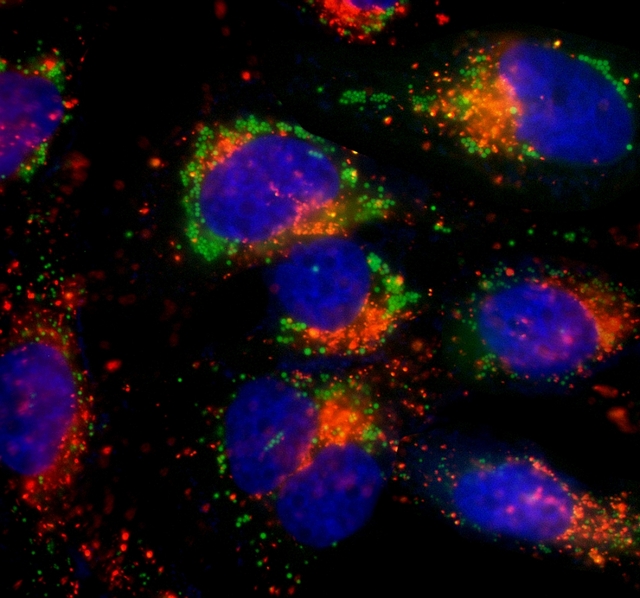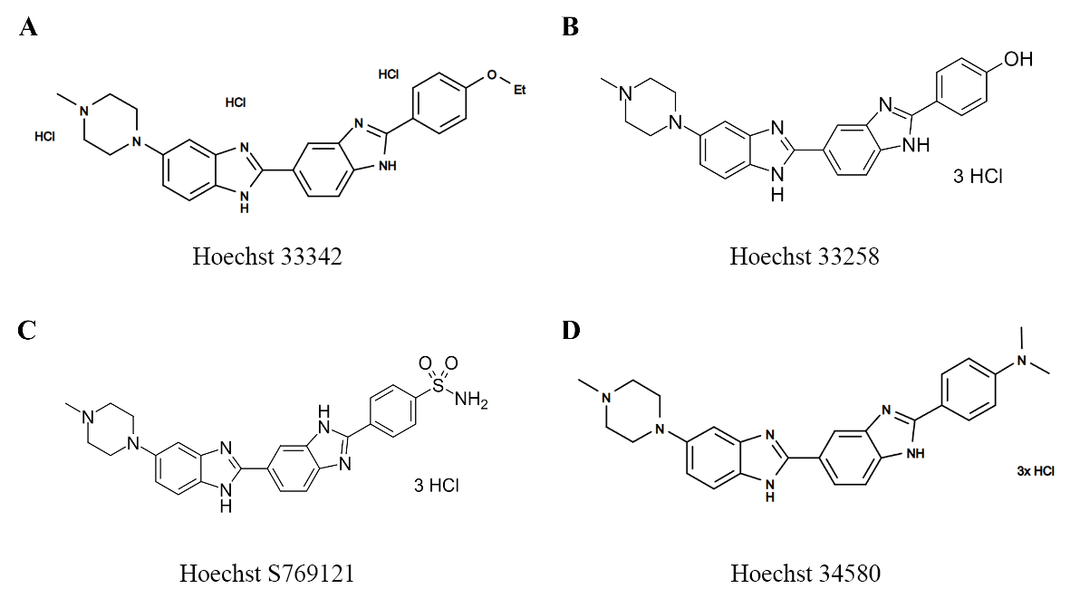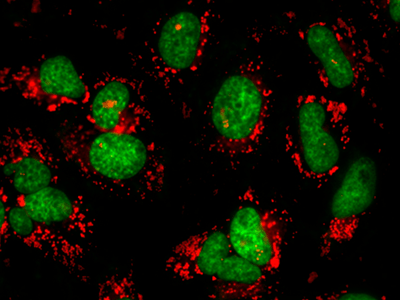Hoechst DNA Stains for Live and Fixed Cells
The bisbenzimide dyes, collectively referred to as Hoechst stains, are membrane-permeant DNA-selective dyes that emit blue fluorescence upon binding to dsDNA. Displaying low-cytotoxic effects and increased cell permeability, Hoechst stains are ideal for live- and fixed-cell fluorescent DNA staining and nuclei imaging techniques, such as cell counting, automated DNA determination, cell cycle analysis, chromosome sorting, and nuclear counterstaining. AAT Bioquest's selection of Hoechst stains includes Hoechst 33342, Hoechst 33258, Hoechst 34580, and Hoechst S769121 (Nuclear Yellow), supplied as solids and UltaPure grade solids. For convenience and ease of handling, Hoechst 33342, Hoescht 33258, and Hoechst 34580 are available as 20 mM aqueous solutions.
Hoechst Stains At-A-Glance
| Dye | Hoechst 33342 | Hoechst 33258 | Hoechst 34580 | Hoechst S769121 (Nuclear Yellow) |
| Ex/Em (nm) | 352/454 | 352/454 | 371/438 | 372/504 |
| Mol. Wt. | 561.93 | 533.88 | 560.95 | 596.96 |
| CAS # | 875756-97-1 | 23491-45-4 | 911004-45-0 | 74681-68-8 |
| Principle | Non-intercalating fluorescent dye that binds to adenine-thymine rich sequences in the minor groove of dsDNA. In solution, Hoechst dyes exhibit minimal fluorescence, but upon binding to DNA, fluorescence increases ~30-fold ensuring a good signal-to-noise ratio. | |||
| Cell Type | Compatible with live and fixed cell and tissue samples | |||
| Fixability | Fixable | Not applicable | Not applicable | Not applicable |
| Filter set | DAPI filter set | |||
| Excitation Sources | Can be excited with a 355 nm UV argon-ion laser, 405 nm violet-diode laser, or a xenon- or mercury-arc lamp | |||
AT-Selective Hoechst Dyes
Like DAPI, Hoechst dyes preferentially bind to the adenine-thymine-rich sequences in the minor grooves of double-stranded DNA. Upon binding, their fluorescence increases ∼30-fold relative to that in an aqueous solution, ensuring a good signal-to-noise ratio. Hoechst stains are well-excited by UV light sources, such as xenon- or mercury-arc lamp, a 355 nm UV argon-ion laser, or a 405 nm violet-diode laser and will emit blue fluorescence in the 430 to 500 nm range. Hoechst 33342 and Hoechst 33258 emit maximally at 454 nm, Hoechst 34580 at 438 nm, and Hoechst S769121 at 504 nm. They may all be detected using the standard DAPI filter or blue GFP filter sets.
While Hoechst 33342, Hoechst 33258, and Hoechst 34580 share much of the same utility, they differ slightly in their properties. Hoechst 33342, with the addition of a lipophilic ethyl group, has the greatest cell permeability and is often preferred over Hoechst 33258 and Hoechst 34580 for live cell staining and cell cycle studies. In the place of a phenol group, Hoechst 34580 contains a dimethylamine group, which results in a shorter-wavelength emission maximum of 438 nm. Hoechst S769121 (Nuclear Yellow) has the longest-wavelength emission of all the Hoechst stains emitting maximally at 504 nm. As a nuclear counterstain in co-localization experiments with other green fluorescent probes, Hoechst S769121 will show considerable amounts of bleed-through into the green channel requiring compensation prior to data analysis. Instead, Hoechst S769121 is often combined with the popular retrograde tracer True Blue, a divalent cationic cytoplasmic stain, for two-color neuronal mapping. Both Hoechst S769121 and True Blue are stable when subjected to IHC processing and can be used to photoconvert DAB into an insoluble, electron-dense reaction product.
The shorter-wavelength emitting Hoechst stains - Hoechst 33342, Hoechst 33258, and Hoechst 34580 - have minimal spectral overlap with other commonly used fluorophores and fluorescent proteins that emit in the green to red range. They are suitable for multicolor labeling experiments, monitoring cell cycle progression with BrdU, identifying replicating cells, chromosome sorting, and automated DNA determination. In flow cytometry, Hoechst dyes are commonly used with propidium iodide or 7-AAD to discriminate between live and dead cell populations or to investigate the stages of apoptosis and cell cycle distribution.
Table 1. Hoechst dyes for labeling DNA in fluorescence microscopy and flow cytometry.
| Product ▲ ▼ | Ex (nm) ▲ ▼ | Em (nm) ▲ ▼ | Unit Size ▲ ▼ | Cat. No. ▲ ▼ |
| Hoechst 33342 *Ultrapure Grade* | 352 | 454 | 100 mg | 17530 |
| Hoechst 33342 *Ultrapure Grade* | 352 | 454 | 1 g | 17533 |
| Hoechst 33342 *20 mM solution in water* | 352 | 454 | 5 mL | 17535 |
| Hoechst 33258 | 352 | 454 | 100 mg | 17520 |
| Hoechst 33258 | 352 | 454 | 1 g | 17523 |
| Hoechst 33258 *20 mM solution in water* | 352 | 454 | 5 mL | 17525 |
| Hoechst 34580 | 371 | 438 | 5 mg | 17537 |
| Hoechst 34580 *20 mM solution in water* | 371 | 438 | 100 µL | 17538 |
| Nuclear Yellow (Hoechst 33258) | 372 | 504 | 5 mL | 17539 |
Hoechst Artifacts from UV Photoconversion
Pronounced exposure of Hoechst stains to UV light causes photobleaching and can photoconvert the Hoechst dyes into green and red-emitting forms, potentially confusing the interpretation of multicolor experiments. This is somewhat troublesome since the microscopist's first step during imaging is to focus on the blue-stained nuclei. To avoid issues arising from photoconversion, consider optimizing imaging conditions, using a mounting media, such as ReadiUse™ Microscope Mounting Solution, to improve stability, or switching to a different DNA stain. AAT Bioquest offers a number of membrane-permeable Nuclear LCS1™ DNA-specific stains in green, orange, and red fluorescence that are relatively non-toxic and do not suffer from photoconversion.
Table 2. Membrane-impermeant DNA-specific dyes for live and fixed cell imaging.
| Product ▲ ▼ | Ex (nm) ▲ ▼ | Em (nm) ▲ ▼ | Unit Size ▲ ▼ | Cat. No. ▲ ▼ |
| Nuclear Violet™ LCS1 *5 mM DMSO solution* | 401 | 460 | 0.5 mL | 17543 |
| Nuclear Green™ LCS1 *5 mM DMSO Solution* | 503 | 527 | 0.5 mL | 17540 |
| Nuclear Orange™ LCS1 *5 mM DMSO Solution* | 514 | 556 | 0.5 mL | 17541 |
| Nuclear Red™ LCS1 *5 mM DMSO Solution* | 622 | 645 | 0.5 mL | 17542 |
| Nuclear Red™ LCS2 *5 mM DMSO Solution* | 651 | 681 | 0.5 mL | 17545 |
| CYTO-13 *5 mM DMSO solution* | 486 | 511 | 0.5 mL | 17553 |
| CYTO-13 | 486 | 511 | 5 mg | 17554 |
| Hexidium Iodide *CAS 211566-66-4* | 518 | 600 | 5 mg | 17562 |
| Hydroxystilbamidine *CAS 223769-64-0* | 358 | 433 | 10 mg | 17514 |
| LDS 751 *CAS 181885-68-7* | 561 | 712 | 25 mg | 17561 |


